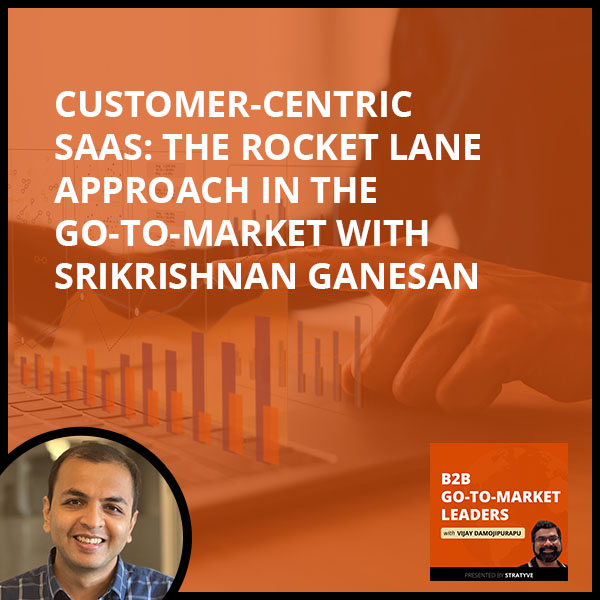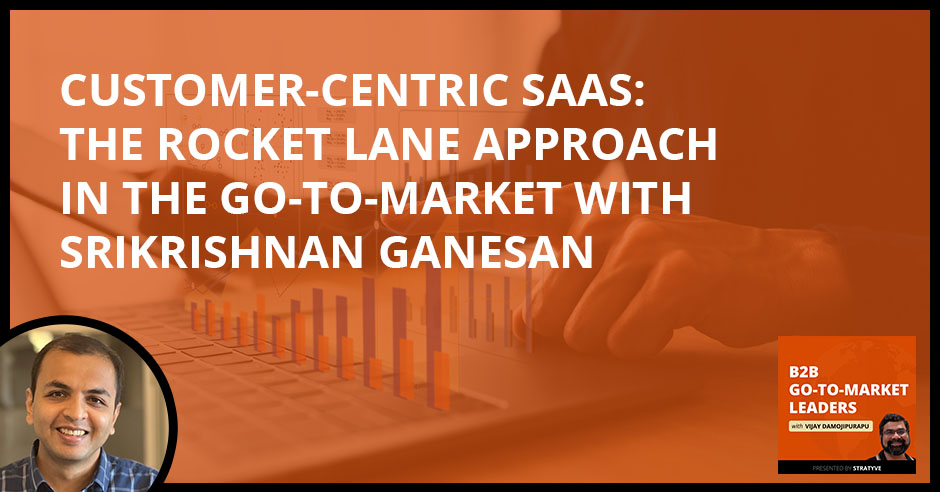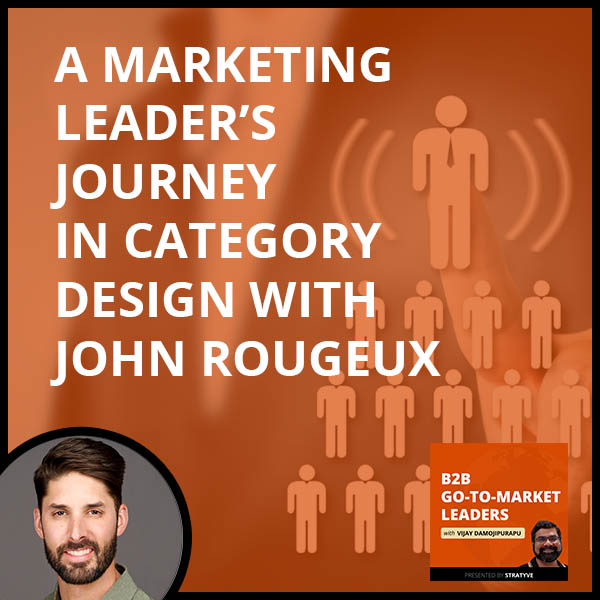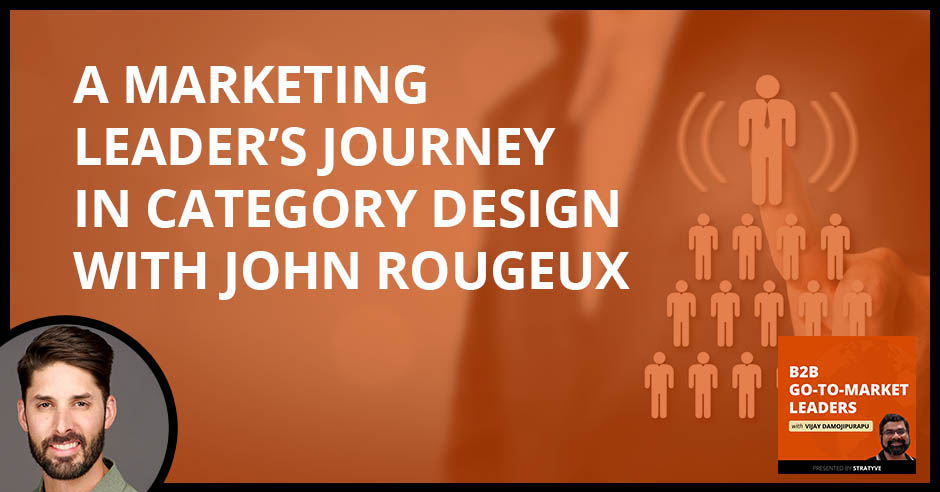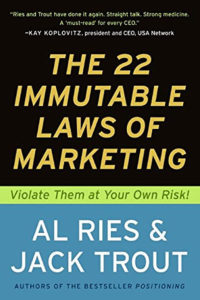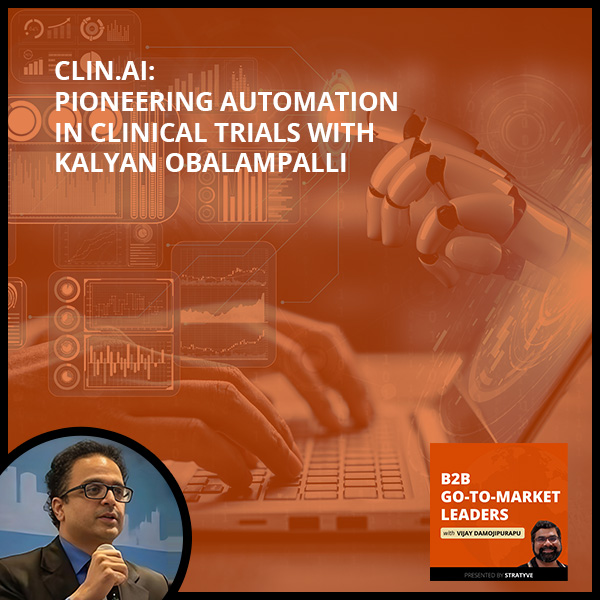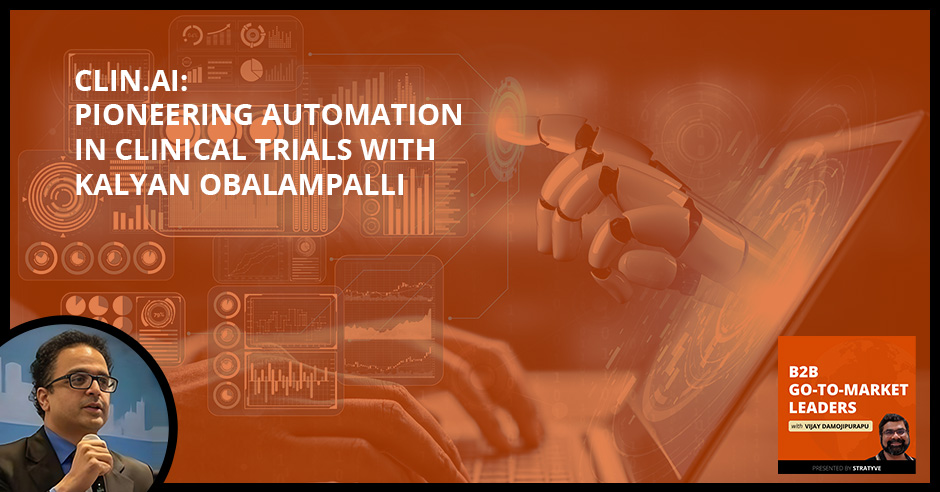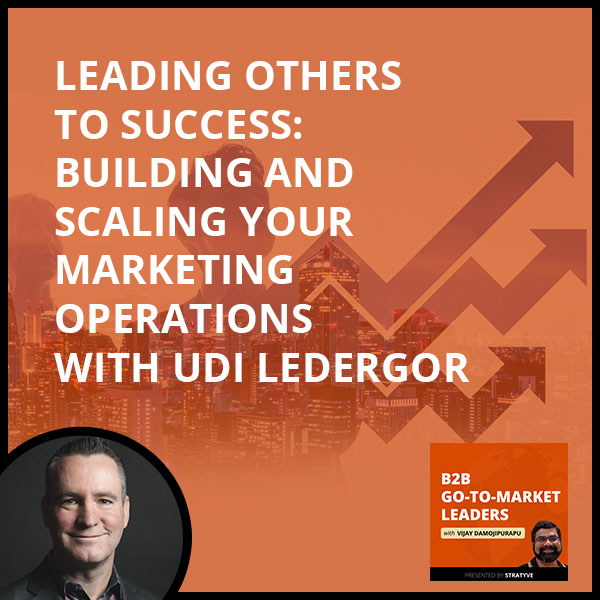
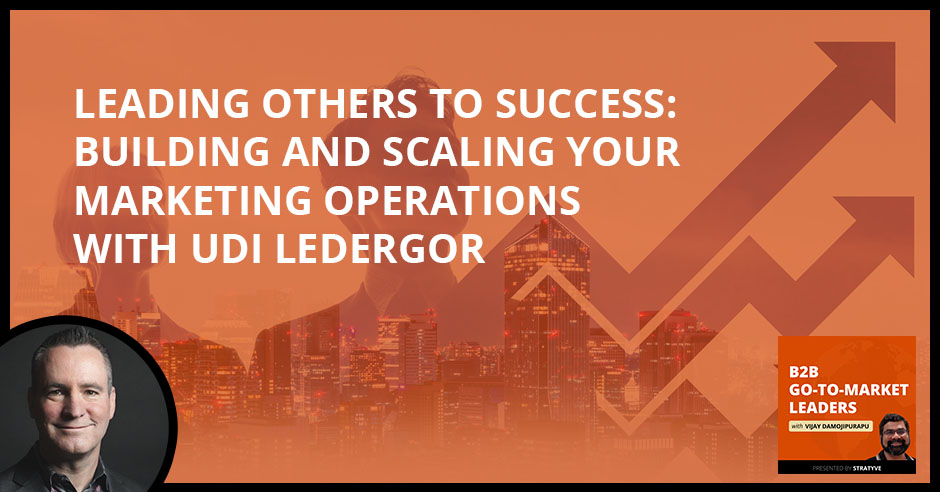
Gong is a revenue intelligence platform enabling revenue teams to realize their full potential by unveiling customer reality. Today, Gong’s Chief Evangelist, Udi Ledergor, shares his secret to leading others to success. As a B2B marketing executive, Udi has showcased his expertise in leading the Super Bowl ad success. He delves into product marketing, and the product marketing’s role is to tell the company story. Join Udi in this insightful episode and see how he and Gong will help pave the path for your success.
—
Listen to the podcast here
Leading Others To Success: Building And Scaling Your Marketing Operations With Udi Ledergor
I have the pleasure of hosting Udi Ledergor, who is the Chief Evangelist at Gong. I’m sure that if you are in the B2B go-to-market and marketing world, you have come across and heard of Udi. Without any elaborate introductions, let’s get right in. Welcome to the show, Udi.
Thanks, Vijay. I’m excited to be here.
This is how I always open the show with a guest, and everyone likes to get right to the topic, which is, how do you view and define go-to-market?
Go-to-market is the process by which a company identifies its target audience. They understand the value that they’re bringing that target audience and how to deliver that value to the target audience. In other words, who are we selling to? What are we selling them? How are we going to sell this?
I like the way and how we emphasize that it all starts with the audience. You didn’t talk about any of the internals or the intricacies that have to happen on the company side, which is the product, marketing, sales, and customer success. You left it out, although it’s understood you are referring to those functions.
Form follows function. If you start with who’s going to report to whom and what we are doing internally, we might miss the bigger questions of who are we selling to, what we are selling them, and how they want to buy from us. If we figure that out, we can build the right org structure, hire the right people, and build the right product to deliver that value.
It all starts with the persona, the people, the segments, and the problems. It all starts and ends there. Everything else is helping the persona to address their problems.
That’s where the elusive product-market fit happens. Many companies fail to find product market fit there. There are multiple reasons that this can happen. One of them is that they were obsessed with building a solution. They’re searching for a problem that that solution solves. Sometimes, they’ll find it, but often they won’t. The other way around, where companies obsess about a problem and look for the best way to solve that problem is usually a more direct line into product market fit and a product you can sell.
I would love to get into that specific topic. Before this call, I was with another founder who built a successful company. They’re still in the early days for several years. They grew from 0 to 400 customers. They raised $18 million in funding. It comes back to what you mentioned, which is the focus on the problems and the people and continuous focus on that. Let’s go to the big picture. Let’s go broad enough. How about you share your career story and journey with our readers and what got you to what you’re doing now?
The first relevant memory would be, as a teenager, I was doing a summer internship in my father’s office, who was working at a big tech/IT company in Israel where I grew up. I saw a bunch of people slouching over their computers, typing away. I thought, “What a boring job. I’m never going to go into tech.” Those are famous last words.
I always loved the performing arts. I dabbled in magic, music, lighting, sound, and everything you can imagine in between. Marketing is the perfect grownup job for someone like me who loves putting on a show, creating an experience, and experiencing that bridge between all the sometimes complicated, messy stuff that goes on in the back to create this clean, simple-looking experience on the outside.
Magicians and musicians do that. When the best of them do it, it sounds and looks effortless. That’s what great marketing looks like. It is when you create a beautiful, simplified experience for your audience where you can simplify complex technology into a simple use case of “Why should I care about this?” You make it seem easy and obvious that, “How did not someone think of this earlier?” That’s how I got into tech or what pulled me in.
Great marketing is creating a beautiful, simplified experience for your audience where you can simplify complex technology. Share on XIn practice, I served in the Israeli military for several years, as most Israelis do, at least back in my day. Towards the end of my service, I was contacted by a company that had won an RFP with the Israeli military to build a simulator for a rocket system that I was an expert on at the time. They were looking for a product manager to be the domain expert and help them build a simulator that closely resembles the operational system. I happened to be the right person in the right place. I interviewed and got the job. That was my first job in tech.
From there, I started exploring all the different things and functions. I taught myself programming. I went along to meetings with the sales manager. I sat around the engineers to see what they were up to. I built prototypes and dabbled with everything. While doing the engineering stuff was fun, challenging, and interesting, I found myself enjoying customer interactions more than anything else.
Fast forward a couple of positions later, I continued in product management for several years. While I was doing that at a company that did not have a fully-fledged marketing function, I proposed building the marketing function myself. I went to my CEO at the time after several years of being a product manager, and I said, “It’s time we build a complete marketing function, and I have the guy for you. I want to take on that job.” He agreed.
After I had hired and trained someone to replace me as the product manager, who happens to be the CEO of that company now, I moved on and became the first VP of Marketing. From there, I did rinse and repeat. I found myself at five different companies as the first marketer. I always sub twenty employees. That’s my sweet spot. I want to come in when there are a lot of things to figure out. I like scaling things that I build myself in those early stages.
I was fortunate to join five startups based in Israel selling globally. We took a couple of them public, got a couple of them acquired, and for the last several years, I’ve been with Gong, which is the third time I’ve worked with my CEO, Amit Bendov. I’ve worked with him at two previous companies over the last several years. When people ask me how I got this dream job, I say, “He called me and asked me if I’m able to help. I said yes. That’s how I got the job.” There are no heroic stories there. I’m building a good relationship and hopefully proving I was valuable in previous roles.
In the last several months, I’ve been the Chief Evangelist. I’ve passed the baton of managing the marketing team to an awesome new CMO that we hired, Brian. I am now focusing on lots of thought leadership and speaking opportunities like what we’re doing here. I’m running an influencer program. I’m taking executive alignment calls to show other executives how I use Gong as an executive myself and enjoying this new phase of my journey at Gong.
Thanks for that CliffNotes version. I’m sure there are lots of ups and downs in there, but something that caught my attention when I was looking up your LinkedIn profile is this interesting and intriguing title, which is Simulator Specialist. That’s what you’re referring to in building simulators for rocket technology.
That was what I was doing. I’m not a rocket scientist, but I am a rocket specialist. I couldn’t find a better title than simulator specialist. In hindsight, everything I was doing was a product management role. I was bringing the user knowledge and preferences to the engineering team and telling them what they should create. It looks to be like the real rocket system that they were simulating. I might go back and change that to product manager at some point, although simulator specialist is a little more intriguing.
It is a conversation starter. You’re simplifying and not giving yourself too much credit, but something that stands out if I or anyone else were to look at your career is how you pick and choose the right startups because that’s where the real formula is. What was your formula in picking those 3, 4, and 5 startups?
I’m happy to go into that. I had a few successes and less exciting choices that I made that I learned something from. The number one thing that I look for that has usually guided me in the right direction is the right leadership. If I had prior knowledge with the leader, like I did when I joined Gong, that would’ve been enough because this is the third time working with Amit. I’ve been working with him on and off for several years. I have well over several years of directly reporting to him. He’s the best leader and manager I’ve ever worked for. If tomorrow he went and started some not-for-profit social impact NGO, I’d probably join him there.
Leadership is where you can’t go wrong. The first time I went to work for him, I asked a mutual friend about him. He said, “You should go work for him because everyone who’s ever worked for him says wonderful things about him.” That was helpful. Do your due diligence on the leaders you’re going to work for. As a reminder, even if you’re in an early stage, fear the later stage in your career. You should be interviewing the company no less than they are interviewing you. If you’re going to commit most of your waking hours for the next several years to the company, it’d better be somewhere with people and a problem you enjoy working on. Hopefully, you are doing some good for the world.

Leadership is number one by far. To generalize that a little bit, I’ve seen more success working with second-time founders or executives who’ve done some meaningful roles before the role that I worked for them. I’ve had some of my more questionable experiences with first-time founders who were young, never had a meaningful position, and what they thought was a great idea and wanted to build a company around it.
Sometimes, the idea was great. Sometimes, it was not great, but their people skills were green. They could be challenging to work with. You can expect that from a lot of first-time founders who have never built an organization and think that having great ideas is enough, but it turns out that the day-to-day job is a lot about motivating people, giving them a sense of purpose, hiring great people and continuing to build the company that way. That’s a little bit about leadership.
Two is looking for product market fit. This is a big one. As a marketer, I excel by having something to work with where there’s an initial product-market fit, and I can go scale that. As soon as we have a product that a certain group of people think is valuable, it solves a painful problem, and they have the budget and authority to buy that solution, I can bring lots more people like that. I’ll find the ways and build an image strategy, brand, and category if I need to. I’ll bring those people to buy the product. If we don’t have that minimum of initial product market fit, we don’t know who we’re selling to, and we don’t know what value we’re bringing them, how can marketing succeed?
I have seen failure both personally and with many talented marketers around me who come into a company without doing their diligence on product-market fit or maybe had a misleading picture of what that product-market fit looks like. We’re all bound to fail. Marketing cannot fix product market fit unless there’s a strong basis there. It’s clearly in marketing’s mandate. If you’re not a product person and you’re not looking to create the right product for the market, but you want to do the core marketing of creating demand gen and bringing people to buy that product, you’ve got to ensure that there’s early product market fit.
There are ways of getting hints of that. If it’s already a product with some sales and not an early stage, there should be reviews up on G2. There should be customer testimonials. You can ask to speak to a couple of customers and see how crucial the product is to their day-to-day, how they use it, and how happy they are with it.
If the product is terrible, people are probably writing bad reviews about it. If they love it, they are writing great reviews about it. You can ask to speak with investors of the company and see what got them excited about investing in that company. Speak to other employees and see what got them excited and what they were surprised about after they started working. Was it better, worse, or the same as what they thought it would be?
Do your diligence and make sure you know where you’re coming from because nothing is worse than leaving a job or celebrating a new job. Several months later, you are discovering things are not as you thought, not as you were told, and you wish you’d done that due diligence. It’s way easier to do it before than be surprised after. I talked about leadership and product market fit. I would also look, especially at times like this, at things like runway. Assuming this is an early-stage startup, it’s early to discuss profitability but understand what the sales trajectory is. If they haven’t started yet, yes, this may be a huge opportunity, but it’s also a huge risk.
If sales have started, what have they been? What’s the trend in the last several quarters? How much money have we raised? When do we need to raise more? How inclined are existing investors to give us more money? If we need new investors, what metrics are we coming up with that are going to get them excited about joining the company? All these are valid questions for anyone joining a startup. If you’re going to risk your best years, reputation, and livelihood for a company, they should be upfront with you about all these things.
Thank you so much for enlisting those. The three things, if I have to echo, first is around leadership, second is around product-market fit, and third is around the runway. I wish I had reached out to you earlier in my career because I didn’t do the due diligence. I know many others in my network who haven’t done that. That was one of the reasons why I prompted this topic, especially in this hard or even improving economic situation. People are still looking out there for new jobs. I want to give this piece of advice to you. Thank you for sharing that. On a lighter note, how do your family members, or even your friends, describe or view what you do in your corporate role?
I was looking at the question, and I was smiling because my husband would explain well what I did. My children, who are ages 8 and 10, would struggle a little bit. That says something about how difficult it is to explain marketing. It’s way easier to explain sales because even as children, they go and buy an ice cream. They understand what sales is, but marketing is a little bit more subtle and indirect. I’ve got eight-year-old twins and a ten-year-old. I heard one of my eight-year-olds being asked, “What does your dad do?” She said, “He works for a company.” That was her explanation. I thought that was sweet, but it also clearly indicates a failure on my part to articulate better what I would do.
This is something that brings me a lot of laughter, even for the guests. A lot of times, unknowingly, we get way serious and head down into our day-to-day jobs. It is those lighter moments, especially when we are with our family members. Quick pulse check and see how they view us and perceive us.
On a more serious note, beyond the nuances of the day-to-day work and explaining that to the children, I hope I’m modeling hard work as an ethic that I’m trying to instill in my children that no good things come easily in life. If they do come easy, they’re probably taken away easily. Working hard, but also setting boundaries for work time and family time, and knowing when to log off, put the phone aside, and enjoy family time, especially now that many of us are working from home. There’s more of an opportunity to practice that and model that for our children.
No good things come easily in life. If they do come easy, they will probably take away easily. Share on XI’m switching gears. I want to dive into two different aspects of your time at Gong. One is the early days when Amit reached out to you. You happily jumped and joined his team. That was the first phase, which is the early company-building phase and your role, what you are doing as a chief evangelist. Let’s talk about the first and walk us through. What is the thought process? How did you, Amit, and others go about finding the product market fit?
The product market fit was initially there. When Amit called me several years ago, he said, “Remember the crazy idea I told you several months ago?” I had coffee with him when we were working at two different companies. He left one company and said, “I’m going to start a company to solve this big problem that I had as a CEO where we had a quarter from hell. I didn’t understand what was happening. Looking at the dashboards, I could see what was happening but not why it was happening. I listened to a few calls, but I didn’t find anything systematic. I thought there must be a better way.”
He joined with a technical Cofounder, Eilon Reshef, our Chief Product Officer. They sat down to think about how they could solve this problem and provide more visibility to business leaders and revenue leaders on what’s happening. They thought that by collecting all these customer interactions, using AI way before it was cool several years ago, and analyzing them, they could surface insights that are actionable that would allow revenue teams to see what’s working, what’s not working, and change their behavior accordingly.
They build something basic. Nowadays, there are dozens of these call recorders. That’s how Gong started. We always had this big vision of how we’re going to help revenue teams. They rolled that out to twelve beta customers in late 2015 and early 2016. Several months later, they thought it was going well. They decided to check how serious these customers were.
They told them, “We’re going to shut off the beta in a few days. If you want to continue using this, you need to write us a check.” Eleven out of the twelve beta customers wrote a check. They didn’t want to shut it off. That’s when they knew that they had hit early product market fit. That’s when Amit called me, and he told me what I told you. He said, “I think we’re ready to market this outside of the friends and family. Can you come to help us?” That’s when I joined.
Did it take about six months from the idea to getting those early?
They started in mid-2015. By early 2016, they were in the markets. In several months, they had the first prototype out there.
We all know once we see the success story, 2020 is hindsight, but that’s typically the blueprint for successful high-growth startups. It’s all about customer validation and not hearsay but what you emphasize there. If I pull the plug on beta, are they ready to shell out money? Are they happy and okay with going away?

That goes back to what I said earlier about being obsessed with a problem and gradually building a solution to address it. We came out with the first solution that we thought would provide some relief from that problem. Once we got that validation, we kept building on top of it. Looking at some other companies where they tinker with the product and they build this whole house of cards over something that they don’t know how stable it is because they haven’t validated with the market, that can lead you down the wrong path.
We do something less drastic because the product is already out there. We’re not giving anything for free anymore. We’re not switching customers off when they can’t pay us. What we do now for new products and new capabilities is we survey customers and ask them on a scale of 1 to 5, how disappointed would you be if we took this away?
We’re not seriously taking it away, even though we do get some angry responses like, “Don’t you dare take this away because I need it.” It is always a good sign, but we want to see at least 40% of our users saying they would be disappointed or very disappointed if we took this away to know that we’ve hit product market fit. That’s a softer way of doing it rather than shutting it off unless they write a check.
You’re the Chief Evangelist at Gong. What does that entail?
Chief Evangelist is a unique role that I was able to put together with the help and support of Amit, my CEO. He used a great analogy when we started this process of adding new executives to Gong. In the last several months, we’ve hired a new chief revenue officer, a new chief marketing officer, and a new chief customer officer, and we’re on the hunt for a chief people officer.
The way Amit explained it to the company was when NASA sends a rocket to the moon, it’s not one rocket like that cute emoji that goes from Earth to the moon. It’s a multi-step rocket that the one piece gets us out to the edge of the atmosphere and falls off. Another piece ignites, and that gets us into the moon’s orbit. When that falls off, the final piece does a gentle landing on the moon. To get back, you’d need a different system.
There are few executives that have taken a company from zero to IPO, not in the CEO seat, but in the CMO and CRO seats, because you do need different people for different stages. I’m an early-stage marketer. I’ve joined five companies with sub twenty employees. I was always marketer number one. I’ve never inherited a team or a marketing operation. That’s where I thrive.
Speaking with other CMOs, I’ve realized that even going as far as I have. I’ve done the zero to tens of millions multiple times, but zero to $250 million as Gong, that’s rare. Most marketers are capped at zero to 50, 50 to 100, or 100 to 500, but zero to 250 ish is a long journey. It was time to bring in folks who have seen the hundreds of millions to billions part of the journey. Those are the people who joined Gong.
I carved out a new, fun role that takes on a lot of the things that I make the most impact with and also happen to enjoy. I mentioned speaking opportunities, thought leadership, running an influencer program, and executive alignment calls. I made that the core of my new role. I’m still making an impact without running a 60-person team. I don’t have an executive assistant anymore. I miss them all. I’m running my own calendar. I’m booking my own flights. I’m getting back to getting my hands dirty and doing work I enjoy without a lot of the red tape that comes with running a large team at a pretty large company.
You’ve shared a lot of insights over there. The most important thing that I took away, especially in the early days of the validation, plus your role as a VP of marketing and the CMO. What is the rationale for you and Amit to switch your role from being a CMO to a chief evangelist? The next segment is more around go-to-market success and a go-to-market failure story.
Before we jump into that, I was listening in and understanding your thought process. How did you build Gong? Even that famous show and talk of yours where you share the secrets around getting 4,000 plus leads from industry trade show. Something that I caught is first principles thinking. That’s the key if I were to convey your formula to others. Would you agree with that?
You’re putting it even more succinctly than I would, but many times, the success of go-to-market motions and marketing campaigns specifically is not about spending millions of dollars. I had a call with a CMO of a large company who wanted to learn about my experience with Super Bowl advertising. He told me, “It’s time for my company to build a larger brand. I saw what a great job you did with the Super Bowl. I want to learn more about that because I’m thinking of doing that.” I said, “I can tell you everything you want to know. I’ve done a couple of Super Bowl ads. I don’t think that’s what’s going to build your brand. It’s going back to the basics. It’s this ‘boring’ day-to-day demand gen stuff.”
It’s not boring, but it’s the stuff that doesn’t get headlines. People love to talk to me about the Super Bowl, and it was a nice cherry on top because 90% of what we were doing in demand gen at the time was working well. I could swing that budget and do an experiment that nobody knew if I was going to succeed or not.
In hindsight, it was fun. I’m glad we did it and elevated the brand a bit, but it was not a pivotal moment, at least not the way I see it in Gong’s brand building. It’s the day-to-day stuff. If you’re going to send an email campaign, and every marketer sends out an email campaign, and you don’t get the performance you want, you’re sitting there wondering what’s wrong, and you start throwing money at the problem. Let’s hire writers and do paid advertising. That’s not what’s going to save you. It’s looking at that email campaign hard and saying, “Would I want to consume this content? If not, why am I sending this out? Why do I expect anyone to read this if I wouldn’t read it? If this is pretended content that’s a thinly veiled sales pitch for my product, why would anyone want to read this?”
Thinking about, “How do you create content that is so good that you would want to consume it? If you want an even higher bar, how do you create such amazing content that people would want to pay you for it?” I know some people laugh and think that’s theoretical. Who would pay you for B2B content? When we created the Gong Labs articles, we would get, every few months, an email from an assistant professor at the University of Illinois, where they have sales courses. She would ask in the name of her professor, “How much would you charge us to license this material because we want to teach it in our university course?”
Another sales and enablement manager is excited about our content. She’s been passing it around internally. She wrote us asking how much it would cost her to license our material because she wants to use it in her official onboarding courses. We love hearing that because we know that we’ve hit that standard of creating content that is good. People are willing to pay for it. To avoid any doubt, we never charged a dime for it. We tell them, “Give us some credit from Gong, but use it as freely as you like because we’re not a content company. We’re a software company. We use content as a marketing investment.”
If your content is not hitting that bar, thinking that you can throw money at the problem is not going to fix it. It’s going back to basics. I like how you put it, Vijay. First principles, why would they open this email? Stop right there. Look at the subject line and look at the sender. Tell me why they would open an email that comes from Info@Acme.com or DoNotReply@SomeCompany.com. Why would anyone open that?
Think about all these little basic things. They don’t cost you money. They need you to switch your brain on and think as a consumer, not as a marketer because you have to rush a campaign out the door. As a consumer, why would I open it? Once you open it, why would I keep reading it? <Once you keep reading it, what would make me take action and click here to watch the webinar, download the white paper, or ask for a demo? If you can’t tell yourself a convincing story about why someone would be persuaded to do that, it’s not going to work. Don’t send it. Stop until you figure it out.
I can hear a lot of audience who go, and their main complaint would be, “You got things working for you, and that’s where you could invest that.” For them, it’ll be either the CEO, the marketing leader, or the sales leader saying, “Spin that next campaign and get those damn leads in.” On your behalf, I would go back and say, “Did you do your due diligence?” Going back to why you picked this job and why you picked this role, leadership, and product market fit. Have they worked on understanding the person and the problem?
Sometimes, multitasking leads to a lack of attention. If you’re trying to do five things at the same time, you’re not giving any of them the right attention to succeed, especially if you’re the first and only marketer or if you’ve got a small team. If you’re asking yourself and them to do many things, you’re not giving yourself a chance to succeed.
If you've got a small and ask them to do too many things, you're not giving yourself a chance to succeed. Share on X
Cut down the number of things you’re doing and do a few things, and they will give you all the pipeline that you need rather than trying to spend money and do twenty half-baked things. None of them are going to work well enough. Focus on fewer things and get them right. Once you’ve got one right, you can scale that. It runs on almost autopilot. You can go figure out the second thing and the third thing. If you are trying to do 5 or 10 things at the same time, there’s almost no likelihood that you’ll get them right.
I’ve been studying similar to the NBA. We have 30 teams, but there’s something magical about those 1, 2, or 3 teams who make it to the playoffs consistently. It’s the same analogy that applies to marketers and CMOs. There’s something magical about those CMOs who’ve been on an ongoing basis. I’ve done research. It boils down to these three things. You can correct me and add to that, but it boils down to content, experiences/events, and community. If you layer one on top of another versus trying to do all 3 or 2 at the same time, that’s a magic formula.
There are variations on that. Some companies have succeeded without building a community. In hindsight, it took me time to realize that we had built a community, even though we never had that as a stated gold when we were putting out all this Gong Labs content. They have started forming a lot of conversation and discussion around it. The same people were commenting on the posts, sharing our articles, and showing up at our events. We created a community without calling it that and without labeling it as an effort to build a community.
We built such a huge following that not only is an audience for what we’re saying, but they’re also becoming ambassadors for what we do, speaking amongst them and arguing about what we’re doing, which is wonderful. The worst thing that can happen is that people ignore what you’re doing. If people are arguing and some of them hate it, that is a wonderful thing because that creates a conversation, and that’s what you want. If nobody’s commenting about your content or about what you’re doing, it’s boring. If nobody hates it, probably no one is excited about it either.
Let’s dive into a go-to-market success story and a failure story. You can pick outside of Gong Labs and the Super Bowl ad because people have heard that story so many times.
I’ve got many to pick from. I’ll pick a random one. A great story was when COVID started several years ago, and we were a few weeks ahead of going out for a road roadshow. We were going to hit 5 or 6 cities because we did a similar one six months earlier. It was a great success. We had everything lined up, booked, and dates, and the world shut down. We needed to decide what to do.
Many companies at the time decided to sit and wait. I don’t blame anyone. Sometimes, you don’t know what to do. You sit and wait because nobody knows how long this is going to happen. Are we going to be home for two weeks or two months? I don’t think anyone imagined it was going to be a few years. Nobody knew. We decided that being biased for action is almost always better than sitting and waiting. There are times when you need to sit and wait, but I’m personally not good at sitting and waiting. Ask my family. I’m much more biased toward action. Sometimes, I’ll take the wrong action, but I’ll take action. Most of the time, it works out well.
Here’s one way that our chief product officer puts it in other contexts. You can think of life as a series of decisions. Most of the decisions are a revolving door. If you realize you took the wrong turn, you can turn around, go back, and take another turn. Most of the life decisions are. There are few decisions that are past a point of no return. You make a decision, and you can never go back from it. There are few of those in life. Jumping off a cliff might be one of those, but we don’t often have to jump off cliffs. Deciding which marketing campaign to run is not one of those decisions.

When everyone was sitting and waiting to decide what to do and see what happens, we decided, “We’re not going to skip a beat. If we said, in two weeks, we’re doing a roadshow, we’re going to do a roadshow, but we’re not going to do it in person because we can’t, the world is shut down. We’re going to switch to a virtual roadshow.”
I gave my team two weeks to figure out which platform we were going to use and how to run a virtual event. We’d never done that before. Let’s figure this out. We did it. For the first virtual event that we decided on two weeks before it happened, we had a thousand RSVPs, and a few hundred showed up for the live event. We went, “That’s more people that would’ve shown up to the combined road show that we were going to run. Let’s keep doing these and get better at them.” We did.
We got good at virtual events. The numbers eventually went up to multiple thousands of people joining an event and being amazed by the experience that we were able to provide them. We got to a point where we had an average attendee time at the event of over two and a half hours. We had some crazies who stayed for 6 and 7 hours because we were running a full day of events. Even during the lunch and bathroom breaks, we had live musicians, DJs, and magicians. It was like a three-ring circus to keep people excited. I could see them dancing and commenting nonstop in the chat. They were having the time of their life. It didn’t feel like a conference. It was like a party in their bedroom.
That was one of the many things that my team did well when we had to pivot very quickly and adapt to what was happening. The easiest thing to do, but the laziest thing, was to sit back, wait and see what happens. We decided, “No, we’re going to take bold action.” We might get it wrong. We spend a few thousand dollars on a virtual event that maybe won’t work, but if we get it right, we’re going to pioneer virtual events for our space. We’re going to get people excited before they get fatigued out of it, which happened a couple of years later. That was a story. I’m proud of what my team did there.
On the flip side, you’ve got type one decisions and type two. That is irreversible but always optimized for the reversible. Most of them it is reversible. On that note, what was a failure story and the lessons that you and your team took?
There are many failures to choose from. Anybody who only tells you about success stories, I would doubt their sincerity. We have lots of failures, but here’s one that I personally learned a lesson from, and this was also during COVID. This was in June or July of 2020. This is after the horrendous murder of George Floyd. It was in the rise of the Black Lives Matter Movement.
We had a quarterly campaign to run to collect reviews for a review site. We had done those campaigns a dozen times before, and we found that we could increase the participation rates if we offered folks a $25 gift card for Amazon or Target. Nothing ever went wrong with those campaigns. We have the idea of what if we try and do something good and we tell people, “We’d like you to write a review for us. We will gladly donate $25 to the Black Lives Matter organization for every review that you write us.”
We didn’t think this through. We felt intuitively that there was a little bit of sensitivity there, but we didn’t realize how much. We sent out the campaign to 6,000 people that we wanted to get their reviews from. Within an hour, I got half a dozen responses. It’s negative. People are writing to me personally, saying, “Udi, this does not look like a Gong campaign. I don’t know what you were thinking. If you want to donate money for a good cause, donate it. Don’t tie it in with something beneficial that you’re asking me to do for your company.”
I got a handful of those in the first hour. I had to make a decision, “What are we doing next?” You could make an argument that if I only got six responses. I pissed off six people, but I sent it out to 6,000 people. That’s one-tenth of a percent. It’s not a big deal, but I decided it is a big deal because my assumption was that for every person who took five minutes to write me an angry email, there are twenty people who are angry. They’re either too angry to write me because they don’t, they don’t care about improving me. They’re angry at me, or they couldn’t find the words or time to take the time. My assumption is if you’re getting a handful of bad feedback, there’s a lot more. They’re not writing.
Within an hour, I decided, “Here’s what we’re going to do. We’re going to send an apology email to all the 6,000 people that got the first email. It’s going to come from my name, owning the mistake and explaining what we’re going to do about it.” We immediately took all the budget that we had allocated for donating to Black Lives Matter. It was $5,000. We immediately donated it without waiting for a single review and letting people know that we’ve donated it. We apologize for the wording of the campaign that went out. It was insensitive on our part.
I sent out that campaign. Within an hour, I got 40 responses. All of them were positive, saying, “Thank you for owning up to that mistake. When we got your previous email, we knew something didn’t quite feel right, but we didn’t have the words to put a finger on it and tell you what was wrong with it. We’re glad that you figured it out and made it right.” That was an important lesson learned.
The two lessons, if to break it down, are one, be hypersensitive to social issues like that and do not do anything that could even be perceived through any lens as taking advantage of a painful situation to benefit your company. That’s one lesson learned. Two, if you do F up as we did, be quick to take ownership, make it right, and apologize. You’re going to get a lot more fans out of doing that than letting it drag out and see, “Let’s see how many people pissed off. If it was only six, it’s not a big deal.” We did the right thing. We got a lot of good karma points for doing that.

It also talks to your leadership and as a person where you are being vulnerable in admitting your mistakes. That goes a long way where you’re creating that convenient or comfortable space for your team. It also shows that you’ve got a good pulse on your customers and audience.
That’s the way to do it. This story was a serious one, but we had other cases where we sent out an ugly typo in a subject line that went out to thousands of people. We also send out an apology email with a little joke in it, owning up to the spelling mistake. It was silly, and we’re all human. Why not admit it? People love doing business with other people who are real human beings and not just shiny brands that pretend that everything is always perfect because it’s not.
Something that comes across during our conversation is, as a marketing leader, a CMO, and a chief evangelist, you emphasize and focus a lot on content, demand, and brand. Something I’ve not heard a lot of is about product marketing. If I speak with a lot of founders and marketing leaders, it goes to 6 to 8 categories. You have the positioning and messaging, competitive intelligence, and sales enablement, especially if you’ve got a sales-led organization. You also have new market launch, new product launch, product adoption, and product content. There are more. What are your thoughts on the role of product marketing and go-to-market? What do you think are the challenge areas for Gong or others that you see in the industry?
Product marketing is the area that I’ve messed up more than any other area. At Gong, we did well with brand, creative, demand gen, comms, events, and content. We built some amazing things in ops. We did a lot of amazing things. In product marketing, I messed up multiple times. I got away with it for a long time because we had that early product market fit. Initially, it was easy to explain the value that we bring, to whom, what it does, why you need it, and why you should care. I didn’t have to build a strong product-market function.
When I did have to, I scrambled and made a few mishires that were good people who did not succeed for multiple reasons at Gong. That team is being rebuilt for a third time. I’m crossing my fingers. They get it in ways that I did not. With that disclaimer aside, the biggest role of product marketing is to tell the company story. You can break that down into company, platform, product, and competitive differentiation.
The biggest role of product marketing is to tell the company story, and you can break that down into company and platform and products and competitive differentiation. Share on X
Gong went from being in a mostly non-competitive space for a long time, and we were the only player people were talking about, to a competitive space because the category that we envisioned all those years ago, we helped usher in as a reality. Everyone agrees that revenue intelligence is a must-have. It’s here to stay, and it’s not a question anymore. We have to shift our product marketing message from explaining why there’s a need for a category like that or what problem it solves. That’s been established. The needs are how we are different and better and why should you care about it compared to all the other solutions in the market. That’s the journey the product marketing is going through.
Product content has a role to play in positioning and messaging. Product adoption is a problem area, given how good the product is in itself.
We’ve been blessed with widespread adoption. Gong has over 4,000 customers and hundreds of thousands of users. The product is being used. That’s why I said it was easy for me to get away without great product marketing, for the most part, because the product did a lot of the work itself. A huge kudos and credit goes to our product and engineering teams that have built something truly incredible. None of my marketing success or my team’s marketing success would’ve been possible without the product that we were supporting.
It’s product content and sales enablement, given this new shift in the messaging. I know you have other things you need to get to in a busy workday. I have a few questions for you, Udi. Who are the 2 or 3 people that played a key role in your career growth?
Amit Bendov was a huge mentor to me in our previous jobs. That made me a candidate for my current job and the CMO job at Gong. I will always be in his debt for helping my career the way he did. Other people that I haven’t necessarily worked closely with, but resources that I keep going back to, are Robert Cialdini’s book Influence. I keep referring to it. Even though it was written in the ‘80s, it is still relevant as ever.
Everything that is happening now on social media and mediums that Robert never imagined in the 1980s is all built on the same principles of human persuasion and psychology. If you dig into those, and I’ve read dozens of books and topics, you’ll create better campaigns. You’ll understand consumer behavior and create better campaigns. That’s another huge resource.
One more is to understand market shifts. It’s a bit of a cliche now, but a good book is Geoffrey Moore’s Crossing the Chasm. It’s another classic from the ‘80s that explains how markets move and how your marketing, go-to-market, and product needs to change as you move from the innovators to the early adopters, to the early majority, and the later majority and the laggards.
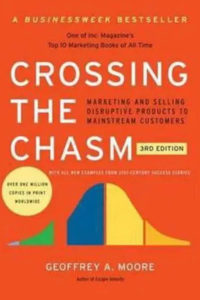
What are the resources that you lean on? You mentioned books and people. I’ve seen your LinkedIn. You’re a big player in Pavilion and other go-to-market communities.
Now that we’re back into in-person meetings and communities, I’m enjoying leaning into some of the communities I belong to. One of them you mentioned is the Pavilion, which holds great events. We have small chapter dinners, larger events, and summits where I enjoy hanging out and meeting people who are friendly and helpful. None of us are pretending that everything is going perfectly. We can sit down and crack problems about team structure or certain parts of marketing that are becoming more difficult and hear how others are dealing with it. I try to go to a lot of those if I can.
I’m also fortunate to be an investor in GTMfund, which is run by Max Altschuler, Scott Barker, and Paul. We had a wonderful weekend offsite a few weeks ago in Napa. Eighty of us came together and had a wonderful weekend together, meeting people who are at similar stages as me in our careers and figuring out what’s next for them and how to balance their full-time jobs with investing and speaking. Doing other things was a huge resource for me.
If you don’t belong to a community that meets in person, that’s ideal. Depending on where you live, it might be hard. If you’re in a small town somewhere, you might have to start with a virtual community and hope they have a couple of in-person events that are even worth flying to. I would highly recommend finding an in-person peer community of like-minded people at similar career stages and functions as you go and share the day-to-day burdens. Even hearing from others about their difficulties and realizing that maybe things are not as bad as you thought for you is also a great relief that you can get from those communities.
Find an in-person peer community of like-minded people. Share on X
I’m part of Peak Community, among other communities. I’ve seen you on the show with Sandra Malders.
I’ve spoken at Peak. That’s another great community there. There are many. There is the Product Marketing Alliance. I’m sure I’m going to offend a bunch of others if I keep going.
My point was not about, “You miss these communities.” It is more about the importance of being part of a community. The final question for you is, if you were to turn back the clock, what advice would you give to your younger self on day one of your go-to-market journey?
Become best friends with sales. That was a realization I came to way too late. Become best friends with your sales leader. You’re never going to succeed unless you do that. If you have this adversity or rivalry with sales and the finger-pointing and the blaming, why aren’t they following up on my leads? Why is marketing bringing crap leads? That’s not going to lead to success. You have to work like a two-headed dragon always together. You can’t win alone. If you try pointing fingers, you’re going to lose out. Become best friends with your sales leader. I’ve written an article about it and done some speaking on it. Welcome to Google Sales Marketing Alignment and my name. You’ll find some of my thoughts on that.
Thank you so much for your time and for sharing a lot of these insights. Once again, good luck to you and the team at Gong.
Thanks so much for having me, Vijay.
Important Links
- Gong
- Gong Labs
- Influence
- Crossing the Chasm
- Pavilion
- GTMfund
- Peak Community
- Product Marketing Alliance
Love the show? Subscribe, rate, review, and share! http://stratyve.com/

